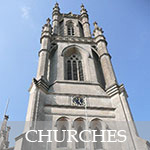Fittleton All Saints, Wiltshire
This fine, mainly 17th century, church is especially noted for its norman chancel, chancel arch and doorway. The east and west windows in the chancel date from the 13th century. The tower is also likely to date from the same building phase. The south wall of the nave contains two 15th century window lights. The church was extensively remodelled by William Butterfield in 1861. In the 1950s the lead roof was overlayed by a shallow pitched tiled roof. A hard, cementitious render was also applied at this time.

The involvement by Minerva Stone in 2003 was primarily related to the removal of the failing cement render. The walls behind were found to be constructed mainly of clunch and flint with lesser areas of brick and limestone. The general condition of the walls was poor and a good deal of re-building was required in order to ensure the complete consolidation of the walls prior to re-rendering.
The consolidation was achieved through a combination of extensive tile
repairs and careful replacement of clunch blocks. The plinth area was particularly
fragile and heavily eroded.
Following consolidation the walls were heavily dubbed out in order to flatten out the walls and then rendered with three coats of lime mortar. A close-faced render was finished with straight grain wooden floats in the topcoat, in order to achieve an open, porous texture.
The finished render was then decorated with four coats of a coloured limewash.
Minerva also carried out rebuilding and consolidation of stonework in the
parapet and gable ends.

